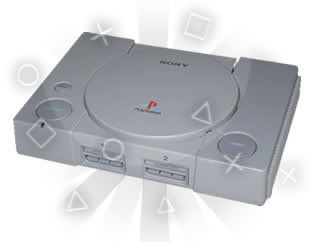
The Falling Out
Back in 1988 Sony and Nintendo formed a joint venture to create a CD-ROM add-on for the Super Nintendo. An add-on drive was to be created followed by a stand-alone combination unit called the Playstation, but due to some financial disagreements Sony backed out of the project quickly. Sony, not wanting to waste all their research and development, decided to utilize what they had from this failed partnership. They took a stab at the video-game console industry on their own and the Playstation was born.
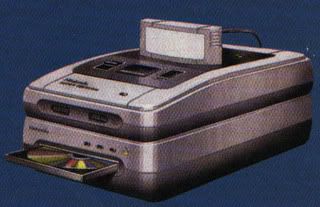
A design sketch of how the CD ROM add on may have looked like
What & When
p>After the Sony-Nintendo deal fell through, Sony travelled their own path by releasing the stand-alone 32 bit Sony Playstation with CD ROM as a storage medium. First off was the Japanese release in December 1994, followed by North America, Europe, and Australia nearly a year later. The Playstation’s direct competition for the time was the slightly more expensive Sega Saturn, and with the Nintendo 64 being over a year a way, Sony had the opportunity to dig their claws into the videogames market. Not long after released to the world, Sony had the first system since Atari's 2600 to top the charts in America, Japan and Europe simultaneously.
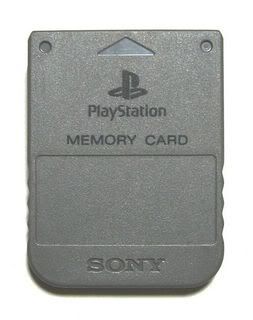
Being a CD ROM based the Playstation relied on memory cards to store save game data.
The Playstation’s phenomenal success was derived from a good combination of attributes. These included the well-known and respected Sony brand name, a lucrative corporate bank account, undercutting the Sega Saturn’s price at launch, a veritable selection of launch titles, solid graphics processing and easy to use Application Program Interface which allowed developers to harness the hardware quickly. By providing easy to use development tools combined with Sony’s already established CD pressing infrastructure, the Playstation was backed up by a very extensive library of games quite quickly, which gave it an advantage over the Nintendo 64’s somewhat limited selection of titles. On the downside the Playstation suffered from a barrage of shoddy titles jam packed with full motion video rather than quality game play, so the ratio of good quality games vs. quantity wasn’t in Sony’s favour.
By opting for a common media it wasn’t long before the Playstation suffered from piracy. Sony made an attempt to combat this by using black-coloured plastic discs that are only transparent to the infrared radiation used by the Playstation’s laser. In addition to that a four-character region code was stamped into the disc during production. However, all of this was in vein up against unauthorized mod chips that circumvented all of Sony’s security measures and region locking.
These days the majority of Playstation 1 titles are compatible with the Playstation and there’s a good selection of PSN games available for down load that will keep the nostalgia alive for time to come.
Playstation Specs
- CPU: 32-bit RISC (33.9MHz)
- RAM: 2MB, 1MB Video RAM
- Graphics: 3D Geometry Engine, with 2D rotation, scaling, transparency and fading and 3D texture mapping and shading
- Colors: 16.7 million
- Sprites: 4,000
- Polygons: 360,000 per second
- Resolution: 640x480
- Sound: 16-bit 24 channel PCM
- Units shipped:102.49 million
Variations
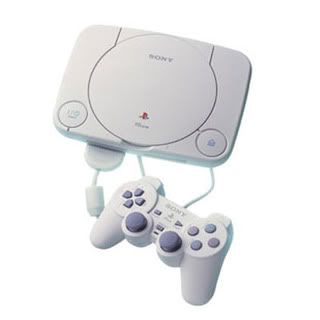
The PSONE with ‘Dual Shock’ controller
Watching the Playstation franchise evolve through its three generations has been interesting and one noticeable trait throughout the series is Sony’s common tendency to refine and re-release its products. This all began with the first Playstation. Over time Sony gradually reduced the number of external connectors and ironed out various hardware faults, and with each re-release a new product code was issued.

The rear of a Playstation with all connections
A special edition Net Yaroze was released. Dressed in black the Net Yaroze was basically a scaled down version of a Playstation developers suite aimed at the hobbyist programmer. In conjunction with your own suitable personal computer the kit including everything you need to get started.
Net Yaroze kit Contents
- 1 Black Net Yaroze PlayStation console
- 2 Black PlayStation controllers
- 1 AC power cord (with UK plug; in France an AC adapter was also included)
- 1 AV cable
- 1 euro AV adapter
- 1 Net Yaroze boot disc (A greenish PlayStation CD-ROM)
- 1 Net Yaroze software development disc (A CD-ROM containing development tools for PC)
- 1 access card (a black memory card-like dongle, required for booting in remote-controlled mode)
- 1 communications cable (a serial cable used to link the console and the computer)
- 1 "Start Up Guide" manual
- 1 "Library Reference" manual
- 1 "User Guide" manual
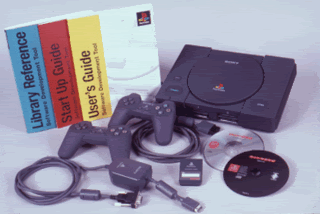
The core console wasn’t the only part of the Playstation that received the redesign treatment. Originally the first Playstation controller was made up of four shoulder buttons, four buttons on the face that use shapes for key reference and a “love it or hate it” sectioned D-Pad. This control pad was replaced with the DualShock controller that had additional dual analogue joysticks and an integrated rumble pack. Sony and their consumers must be pleased with this design because not a great deal has changed throughout the series apart from a few technical enhancements to cater for the changes in various game designs.
Ridge Racer
Gran Turismo has sold over 10 million copies







No comments:
Post a Comment